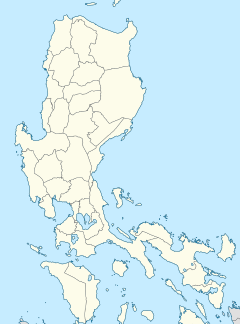Sideco House
| Sideco House | |
|---|---|
Bahay Sideco | |
 The house viewed from the southwest | |
| Alternative names | Crispulo Sideco House |
| General information | |
| Status | Completed |
| Architectural style | Bahay na Bato |
| Address | Vallarta cor. P. Carmen Sts., Poblacion |
| Town or city | San Isidro, Nueva Ecija |
| Country | |
| Coordinates | 15°18′41.4″N 120°54′15.1″E / 15.311500°N 120.904194°E |
| Elevation | 24 metres (79 feet) |
| Technical details | |
| Floor count | 2 |
The Sideco House, also called the Crispulo Sideco House (Filipino: Bahay Crispulo Sideco), is a historic house located in San Isidro, Nueva Ecija, Philippines, close to the Pampanga River. It was once the headquarters of the First Philippine Republic in 1899.
Background
[edit]The municipality of San Isidro was proclaimed as the capital of the Philippines on March 29, 1899, by General Emilio Aguinaldo,[1] the recognized first president of the Philippines. During his stay in San Isidro, the house owned by Captain Crispulo "Pulong" Sideco served as the de facto residence and office of Aguinaldo as president.[2]
The house ceased to be the presidential seat when San Isidro fell to the Americans on May 17, 1899.[3] This caused Aguinaldo to move the government seat to Angeles, Pampanga.[2] The March 1901 capture of Aguinaldo, which ended the First Philippine Republic, was planned in this house by American General Frederick Funston.[3][4][5]
Images
[edit]-
House with the two NHCP markers.
See also
[edit]References
[edit]- ^ Navasero, Mandy (2001-09-29). "Mayor Sonia Lorenzo and Historic San Isidro". Street Smart. Philippine Daily Inquirer. p. E2 – via Google News.
- ^ a b Laya, Jaime (2021-10-11). "Be it Ever so Humble (or Grand) … (Part VII)". Wala Lang. Manila Bulletin. Retrieved 2021-11-29.
- ^ a b Dumindin, Arnaldo (2006). "Capture of Aguinaldo, March 23, 1901". Philippine-American War, 1899-1902. Retrieved 2021-11-29.
- ^ Foreman, John (1906). The Philippine Islands: A Political, Geographical, Ethnographical, Social and Commercial History of the Philippine Archipelago, Embracing the Whole Period of Spanish Rule, with an Account of the Succeeding American Insular Government. Shanghai: Kelly and Walsh. pp. 509.
- ^ Funston, F. (1911). "The Capture of Emilio Aguinaldo". Memories of Two Wars: Cuban and Philippine Experiences. C. Scribner's Sons. ISBN 978-0-7222-7898-7.













